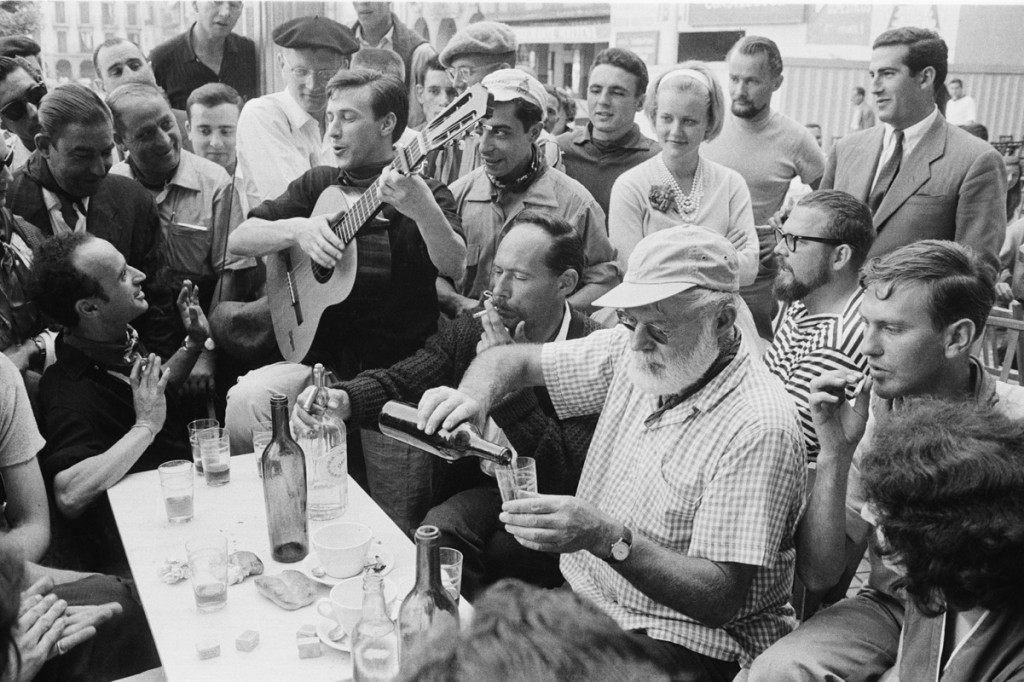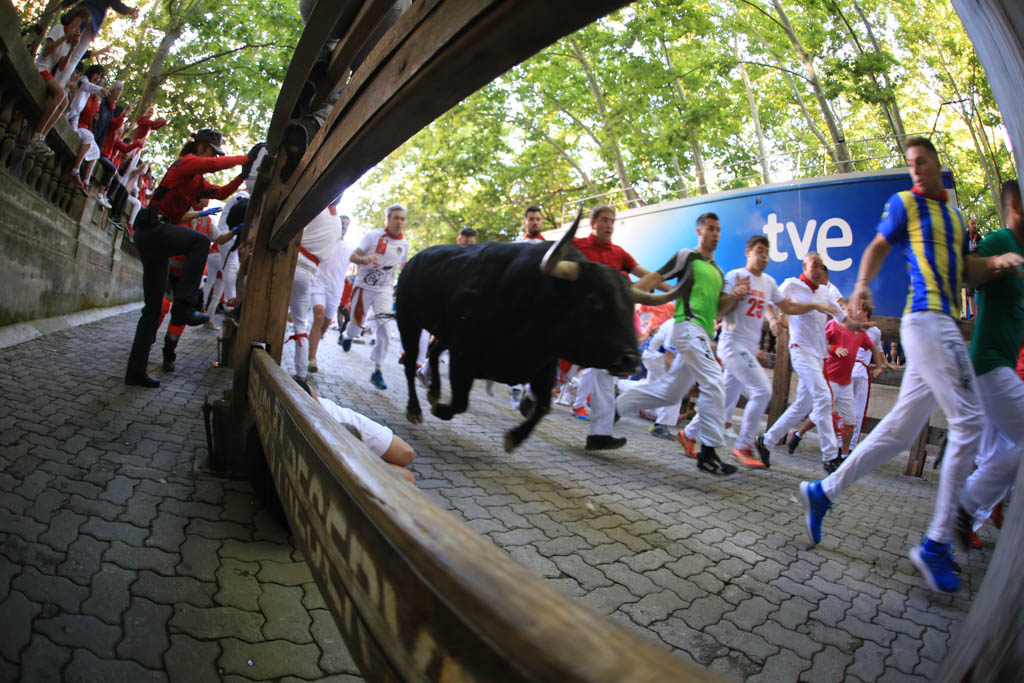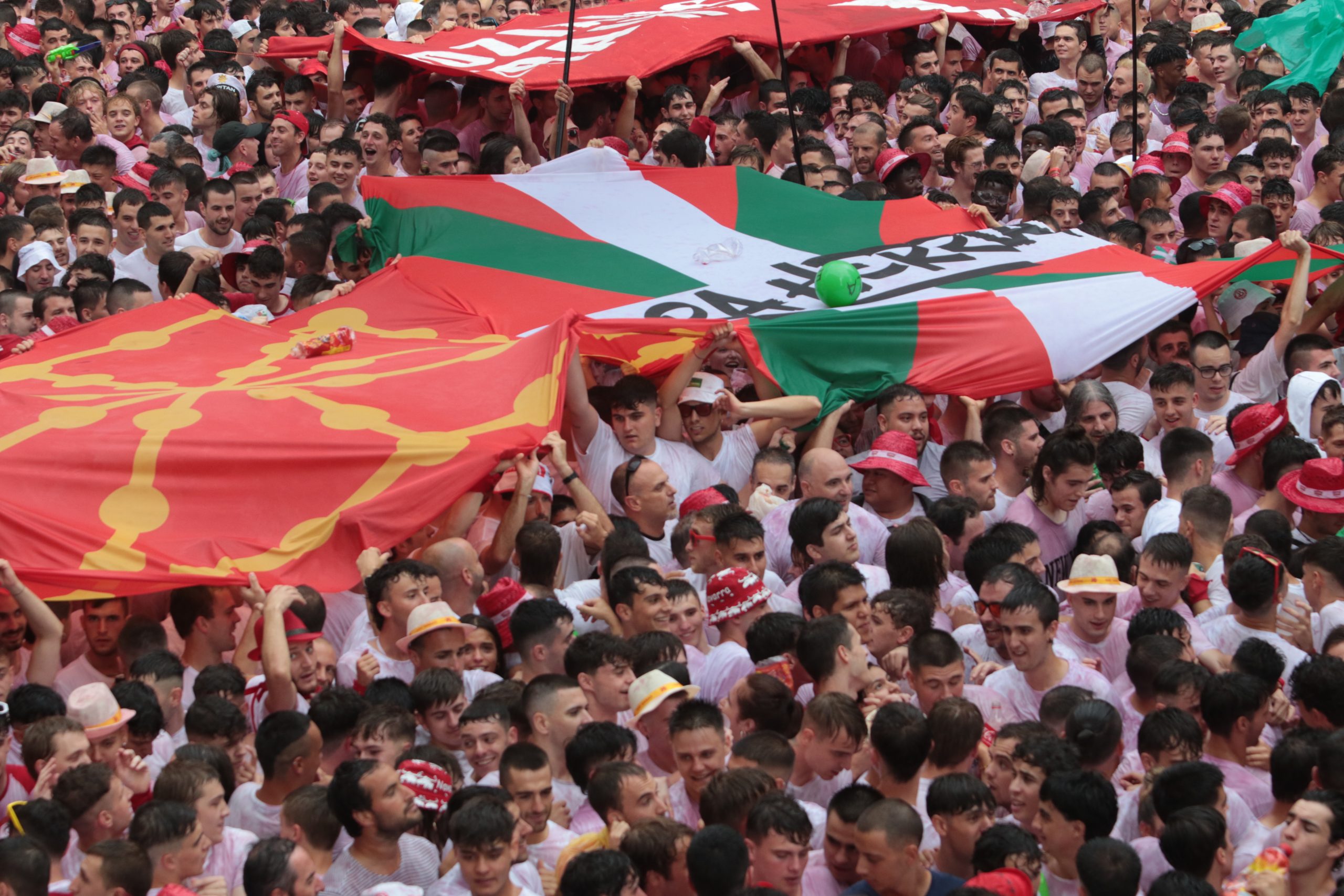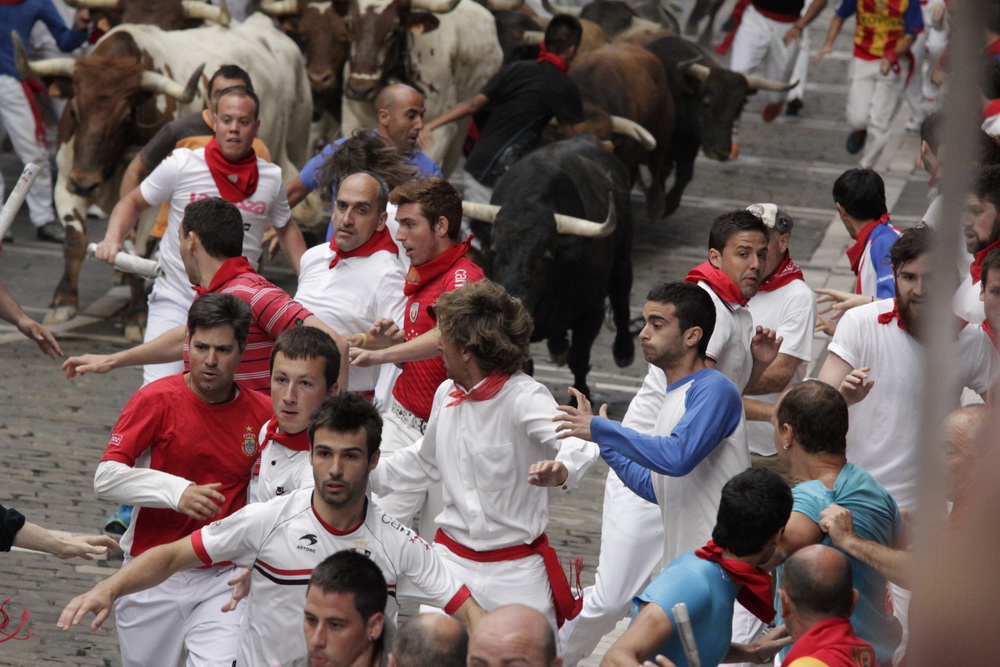Photo: Julio Ubiña.
From 1923 to 1929
1931
1953
1956
1959
¿Corrió Hemingway el encierro de Pamplona?
Hemingway Touristic Route on Pamplona
The Running of the bulls & The Sun Also Rises
Hemingway and Sanfermin
Ernest Hemingway was born in the United States, in Oak Park (Illinois), in 1899, and died in Ketchum (Idaho), on the 2nd of July, 1961, leaving some tickets for the pending Sanfermin bullfights of that year on his hallway table. Hemingway first came to Sanfermin in 1923 and paid his final visit to the annual fiestas in 1959. Just a few days before his death, he personally called up the Hotel La Perla in order to cancel his booking made for Sanfermin for that same year. In 1953 he was awarded the Pulitzer Prize, and in 1954 he was awarded the Nobel Prize for Literature. He left behind five unpublished works and some 3.000 manuscript pages.
He chose a career in journalism at an early age and he published his first reports in the Kansas City Star. He had lied about his age in order to leave home and join as a volunteer in the First World War as an ambulance driver. He was wounded in the Italian front and then returned home. He first visited Pamplona for Sanfermin fiestas in 1923, followed by nine further visits.

When it comes to remembering Hemingway and his close relationship with Pamplona the words of Jerónimo Echagüe come to mind: “The day will never come when Pamplona is really capable of admitting the good that Hemingway has done for this town of Pamplona. Here, the foreigners don’t come to colonize us, as happens in other places, but rather to integrate themselves in our fiestas. This is something we can see year after year, although there will always be some exceptions to the rule.”
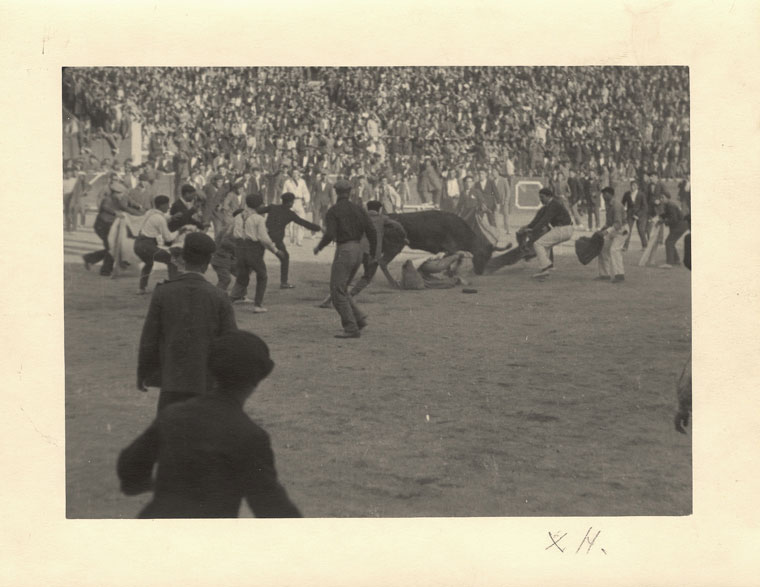
Hemingway en la plaza dando un pase a una vaquilla. Photograph in the Ernest Hemingway Photograph Collection, John F. Kennedy Presidential Library and Museum, Boston.
From 1923 to 1929
Hemingway visits Pamplona for the first time, already a correspondent of The Toronto Star, while he was living in Paris, where he had already met people like Picasso and James Joyce. On his first visit to Pamplona in 1923, Ernest Hemingway was looking for material to finish off a series of twelve short reports. His impressions of Sanfermin, especially after the running of the bulls on the 13th of July, are approving and they are reflected in the report printed in The Toronto Star on 23rd of October and later in his own literary work.
In 1924 he returns for a second visit, accompanied by his first wife, Elizabeth Hadley, and a group of friends, among them Robert McAimon, Donald Ogden and John Dos Passos. In Pamplona he meets Juanito Quintana and he also takes part in the running of the bulls. He is a witness to the death of the first mortal victim in the running of the bulls, Esteban Domeño. A false rumor is spread abroad that both Hemingway and Donald Ogden had been gored by the bulls.
In 1925 he comes to Sanfermin fiestas with the idea of gathering material for a novel, encouraged by his friend in Paris, Gertrude Stein. Hemingway was a witness of the comeback of the bullfighter, Juan Belmonte and he becomes a fan of Cayetano Ordoñez. He begins to write “Fiesta”.
In 1926 Hemingway was back again in Pamplona for the fiestas and this year he discovered Casa Marceliano and favorite dish of ajoarriero. In October, his novel is published under the title “The Sun also Rises” in Europe and “Fiesta” in The USA. This novel had a successful impact on both Pamplona and Sanfermin as it opened the fiestas to a world-wide public. Hemingway was witness to the inept performances of El Niño de La Palma, (Cayetano Ordoñez) and he would later publish the account in “Death in the Afternoon”.
In 1927 he is back again for the Sanfermin fiestas. This year he comes without his first wife and accompanied by Pauline Pfeitter, a journalist who had accompanied him and his wife on previous visits. He was now a familiar figure on the terrace of the Iruña, in casa Marceliano and the lobby of La Perla hotel. In his bullfighting book, “Death in the Afternoon”, he would later write about the bullfights he saw on the 14th of July that year, with a gypsy, Cagancho, as protagonist.
In 1929 Hemingway arrived by car to Pamplona from Paris with his now-wife, Pauline. Fernando Huarte quotes in his book, “Cien años y una huella” a story told by an old employee of the Hotel Quintana, Eustaquio Ardanaz. Here he relates how, while Pauline was sleeping, Hemingway appeared in a rather drunken state at the hotel, accompanied by two women. Soon afterwards the two women were seen fleeing from the place with Hemingway chasing behind them in his underwear and shouting for them to come back. Juanito Quintana, the manager and friend of Hemingway, had to have a serious talk to him and warn him that any further behavior like that would mean throwing him out of the hotel.
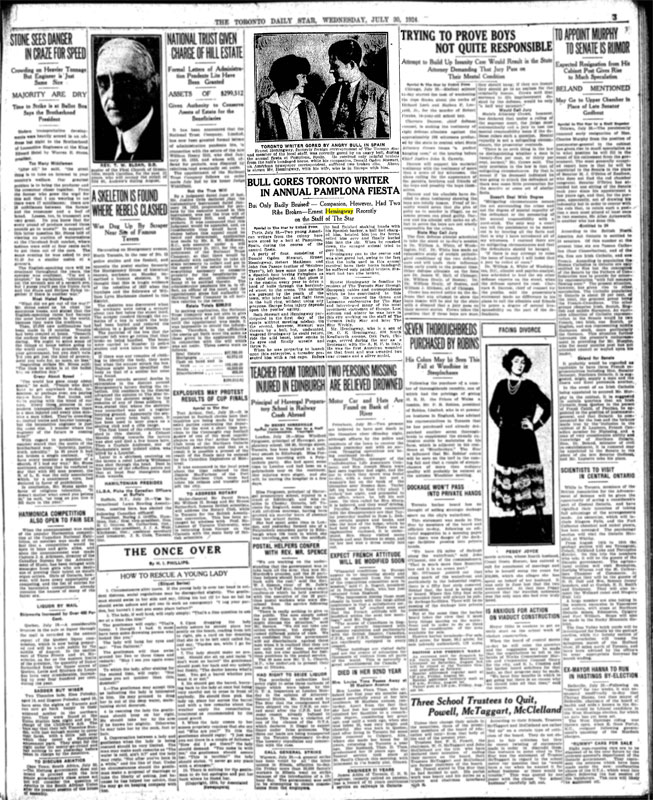
EL Toronto Star Publicó que dos jóvenes escritores americanos habían sido cogidos por el toro en Pamplona.
1931
In 1931 Hemingway turned up at the Sanfermin fiestas accompanied by his wife Pauline and his son. Fernando Hualde confirms this circumstance with the publication of a single photo taken in the bullring that year. This year he also got material for his book on bullfighting, “Death in the Afternoon”. Manolo Bienvenida, after two awful performances, closed the bullfighting week with poor cape work and no style.
Hemingway worked hard on getting the proper bullfighting vocabulary for his new book on bullfighting and perhaps for that reason his visit was more discreet that year. He continued his friendship with Juanito Quintana and they both had long talks about the new Second Republic now installed in Spain and towards which both of them felt favorable. This change in the political climate, the fact that Hemingway had more and more work on hand and the disappearance of the Hotel Quintana, all contributed to the fact that Hemingway would not return again to the fiestas for 22 long years.
In 1953, he comes back and stays at Hotel La Perla room number 217
After 22 years, the fiestas were the same as ever, but the atmosphere was becoming filled with more and more foreigners in search of the “Fiesta” experience as narrated by Hemingway. In 1953 Ernest Hemingway returned to Pamplona after an absence of 22 years. His experiences in the Civil War and his political empathies made him reluctant to return to Spain but in fact his visit went off very well. Hemingway was accompanied by Juanito Quintana during most of his stay even though he did not now run an hotel. The author arrived with his wife Mary and stayed in Lecumberri at the advice of Quintana. But being so far from the center of the fiestas did not suit Hemingway and on the 7th of July they couple checked into room 217 of La Perla Hotel in the main square of Pamplona. On earlier visits Hemingway had witnessed the bullfighters dress and prepare themselves for the bullfights in this hotel.
That year too Hemingway gave rise to much public comment when he visited the chapel of Sam Fermin after the procession where he prayed devotedly to the saint, as reported in his Book “Hemingway and the Sanfermin fiestas”, written by José María Iribarren. Given his political and progressive leanings, Hemingway was once asked by Octavio Aparicio in an interview who he considered the most interesting person in the town …and Hemingway answered San Fermin.
Hemingway saw Antonio Ordoñez, the son of Cayetano, fight for the first time and he was deeply impressed by his performance. That same night, after the successful afternoon, both men had dinner together in Los Pocholas.
1956: a cardboard box full of notes changed his plans
In 1956 there is no record of Hemingway’s attendance at the Sanfermin fiestas, but he passed through Pamplona where he picked up Juanito Quintana on his way to the bullfights in Logroño in September. He had a meal in the Pocholas restaurant. Hemingway visited Pamplona sporadically during 1956, but there is no record of his attendance at the Sanfermin fiestas. He had also recently been awarded the Pulitzer and a Nobel Prize and the popularity of Fiesta had not waned.
There is also an anecdote that accounts that when he checked into the Ritz Hotel in Madrid, an employee remembered that he had left a box behind him there some thirty years before. On receiving the cardboard box, Hemingway discovered that it was full of papers and notes of his about Paris. He spent a couple of weeks going through everything and this upset his plans to go to Sanfermin fiestas. From these old notes he wrote his book “Paris was a fiesta.”
Hemingway passed through Pamplona in September when he stopped to pick up Juanito Quintana on his way to the Logroño bullfights. He was seen at the bullfights in Logroño on the 21st of September. Ordoñez fought that day along with Litri and Cesar Giron. His fourth wife, Mary Welsh, accompanied him along with Juanito Quintana and an ex-RAF pilot, Rupert Belloville, who had ambitions of becoming a bullfighter. Look for photos.
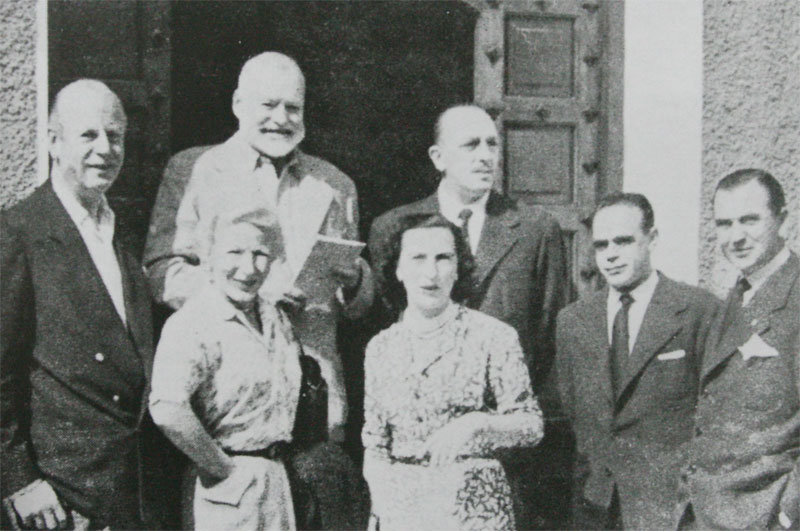
En 1956 Hemingway pasó por Pamplona y comió en el restaurante Las Pocholas.
1959: Hemingway was the star attraction in the fiestas
In 1959 Hemingway once again stayed at room 217 in La Perla Hotel. It was to be his last visit to the Sanfermin fiestas. Fernando Huarte, in his book “Hemingway, cien años y una huella” states this year during Sanfermin fiestas, Hemingway was the star attraction. Everyone wanted to be seen with him, to have their photos taken with him and everyone wanted his autograph.
He came to Pamplona with a large party from Madrid, among them the bullfighter Antonio Ordoñez, Dr. Vernon Lord, TV writer Aarón Hotchner, the young Irish journalist, Valerie Danby-Smith and the photographer Julio Oubiña. This photographer did a special photographic report on the banks of the reservoir at Yesa, for the prestigious Life magazine.
Did Hemingway ever take part in the running of the bulls?
Fernando Hualde says he did in his book – “Hemingway. Cien años y una huella”. Hemingway took part in the running of the bulls for the first time on the 7th of July, 1924 accompanied by Donald Ogden Stewart and, according to the above-mentioned author, without getting close to the bulls. From the book “Historia de los Sanfermines” by José María Iribarren as well as from statements made by people who knew Hemingway, we know that he did not like to take any risks in the running of the bulls.
Many people now believe that he never ran in the running of the bulls and that he was afraid to take part. However, in a photo which illustrates a page in the book and which belongs to the John F. Kennedy library in Boston, we can see him playing with the young bulls in the bullring just after the running of the bulls and he certainly does not look like someone that is afraid.
That snapshot was taken in 1927 but it could just as well have been taken in on the 8th of July, 1924 when a news report was sent out around the world. One of the young bulls knocked over Donal Ogden and Hemingway tried to pull the animal away by grabbing it. He too received a knock from the young bull. According to Fernando Hualde, there is no medical report list for that day nor does the local press make any mention of injuries. In spite of that, in The Toronto Star published a report that stated that Donal Ogden had suffered two broken ribs and that Hemingway had been fined for misbehaving.
In addition, Hemingway sent United Press a report that he had been gored by a bull and this news agency spread the news all over the world. The repercussion was quite astounding even though it was based on a falsehood.
That same year, in 1924, on the 13th of July, Hemingway was an eye-witness to the first death in the running of the bulls, when Esteban Domeño from Sanguesa, was fatally gored. That event made a deep impression on Hemingway and set off his concept of the duality of death and fiesta, which he later set down in his novel, Fiesta.
Hemingway Touristic Route in Pamplona
Sanfermin and Hemingway have a close relationship and many people follow his steps when he himself visited Pamplona for Sanfermin, with the excuse that it provides quite an interesting tour round the city. You can book with shop.sanfermin.com a visit walking Pamplona.
While some of the places he frequented no longer exist, some of the most notable places still do exist today. In the main square of the plaza del Castillo, Ernest Hemingway used to move from bars such as the Txoko and the Café Iruña – still in existence today – as well as others such as the Café Bar Torino, Café Kutz and Café Suizo, all of which have now disappeared. On the round of his favorite spots there is also a place for the Gran Hotel La Perla, where he stayed on some of his trips, and the Hotel Quintana, which has now disappeared.
In addition, the route would take us to some of his favorite eating places such as the now extinct Casa Marceliano and recently-closed restaurante Las Pocholas. The building of the boarding-house where he stayed in on his first Sanfermin trip can still be seen in the Calle Eslava. Finally, two spots connected with his love of bullfighting; the Hotel Yoldi, which used to be the favorite hotel of the bullfighters and to which Ernest Hemingway would go to see the toreros. And, of course, the bullring is still the same one where he used to attend the bullfights.
Perhaps to fully complete the Ernest Hemingway route in Sanfermin it would also be necessary to visit the towns and rivers where he used to go to fish such as the villages of Aribe, Burguete and Roncesvalles. He once appeared in the bullring with his fishing boots still on his feet after a day’s fishing up in the hills.
Ernest Hemingway, Sanfermin at films
The most quoted film of all on Sanfermin is “The Sun also Rises”. This movie adaptation of the Hemingway book was made in 1956 with Henry King as director. The movie was shot in three different locations, in the Hollywood studios, in Pamplona and in Morelia, in Mexico. Just one camera team came to Pamplona in 1955 in Sanfermin and they filmed background scenery material as no actors were brought over. In Morelia the streets and bullring were adapted to fit the settings and it was here that the actors played out their roles. Tyrone Power, Eva Gardner and Errol Flynn played the leading roles. The bullring is the Mexican version and the other background settings are studio creations.
The American public did not notice any difference but Hemingway himself did, and he was angry about this fact. This film version was not shown in Pamplona until 1978 due to a censorship ban Teddy Villalba, the classic American movie producer, who was awarded an honorary Goya, used to talk about the difficulties in the shooting “because at that time we were getting one over on the Government, leading them to believe that we were filming something on the Sanfermin fiestas, but in fact, they were shots to be included in the film “Fiesta”, which had been banned from being filmed in Spain.” A photo taken in Las Pocholas restaurant testifies to that time as it shows Villalba and his film team accompanied by Orson Welles, Antonio Ordoñoz, Ernest Hemingway and Luis Miguel Dominguín.
Another film which makes reference to the running of the bulls is precisely that which Orson Welles was then filming with himself as Don Quixote and visiting different traditional fiestas. With regard to this movie, Villalba affirmed recently that they had to give some film negatives to Welles as he was filming on such a tight budget that he had no money for more film. “Fiesta” has had other film versions. There is a TV version which is not very well known. It was made in 1884 and directed by James Goldstone and it was re-shown on the British Channel 4.

